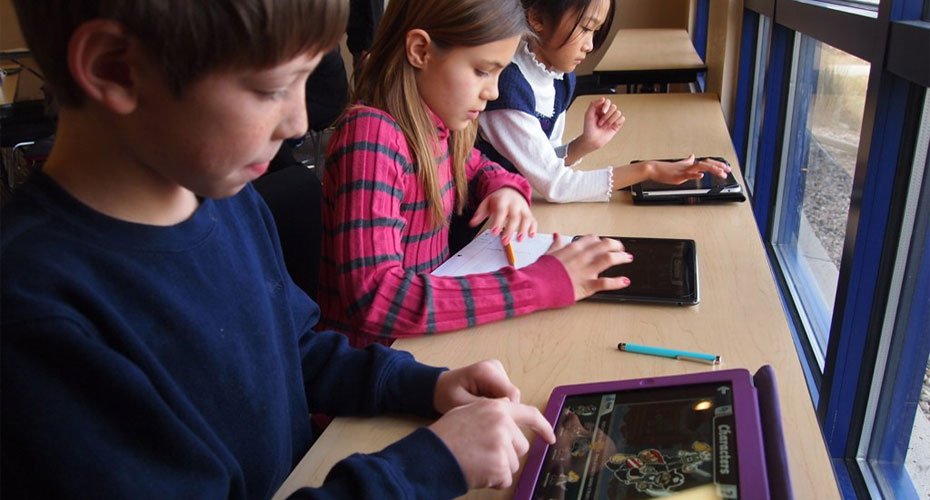Visit 1 Activity 2
Producing an 'event timeline' in Padlet
Context
10:00 – 11:10 (break 10:30 – 10:50)
Children remain sitting in pairs, at tables, in rows, facing the teacher and IWB, with their Chromebook and writing resources. The teacher moves from the IWB to her desk to use her laptop, and circulates around the children as they work. This activity is interrupted by a 20-minute planned break. The children will produce a story timeline on their Chromebook, using Padlet.
Key activities
- Teacher models and guides children’s use of Padlet
- Teacher models how to plot a story using a Padlet timeline
- Children use Padlet to produce a flow chart to showcase their understanding of the order of events in the story
- To understand the order of the events in the story
- Interactive White Board
- Chromebooks (one per child)
- ebook resource: The Bewitched Forest – Inspire Literacy
- Music from The Bewitched Forest resource
- Comprehension question activity in the digital resource
- Padlet
- Scaffolding children to elicit the key events
- Scaffolding children to order the key events in the story
- Collaboratively constructing a story skeleton
- Recount of key events
- Explanation (of ideas to class)
- Summarisation of key events for timeline
- Writing in Padlet boxes
- Did the children enjoy using Padlet to sequence the events in the story?

Lesson Commentary
Introduction
Teacher models and guides use of Padlet
The children are given a new task: to open Padlet on their Chromebook and create a timeline of events in the story. The teacher guides the children to do this. A lot of instructions are needed to remind children how to manage this, e.g. to traverse from one tab to another. The teacher addresses the class from the IWB and models what to do. She reminds them of the task: to map out the sequence of the events of the story. The children have played with padlet before – and some have practised using it at home – in preparation. The teacher explains that as they can only have 5 free Padlets, they may need to delete some practice ones. Children spend time selecting their background for a new Padlet.
- Children have created individual Padlet accounts in a previous lesson and are building on these less formal experiences
- Children need step-by step teacher modelling support to access Padlet
- Children navigate across digital resources, from close up (laptop) to more distant (IWB), with ease – from Padlet to IWB
- Children navigate across digital resources – from Padlet to the interactive story, with ease
- Time is needed for children to play their way into using the Padlet resource for their narrative writing task
- The teacher’s role is central to the success of the activity. There is a high-level of teacher control as she directs children to play their way into the activity
- Instructions are staged and released one-at-a-time
- The teacher’s role shifts from being the locus of control, to being a resource alongside the IWB and Chromebook/ Padlet
- The children’s attention shifts easily from their Padlet to notes made earlier, to the example on the IWB, as they build a timeline
- The teacher is a presence and scaffold at all times. She is audible above the hum of chatter, helping children, and offering advice and feedback, as she moves around the room.
- This is a sustained writing activity
- The entire activity feels like collaborative writing, due to the teacher’s presence and the children’s interactions with each other – although children are producing individual timelines
- The process feels very fluid
- The children have agency as writers, despite the staged and scaffolded approach
- Building a Padlet timeline replicates a familiar writing stage (from established pedagogy)
- Children’s sustained engagement is driven by how the teacher has scaffolded the writing activity; rather than the digital resource. The resource is an accessory
- Composing a Padlet timeline is a comfortable experience. Children look comfortable, working on the Chromebook to record ideas
- Children’s agency and engagement as writers is promoted by the affordances of the resources – being able to dip in and out of the interactive story; being able to tab from Padlet to the story to find and record ideas; being able to search for images to use in their Padlet
- The activity supports them to generate ideas (compose), record ideas (transcribe), and reread and improved (review), as part of the overall writing process (planning stage)
- Padlet is a free resource, as well as a resource that can be subscribed to
- Free app versions of resources might have limited functionality – e.g. only 5 free Padlet sandboxes are allowed per user, currently
- How to use Padlet to record ideas in a sandbox
- How to build a timeline in Padlet, using the timeline feature
- The extent of children’s prior experiences using Padlet
- How story skeletons can serve as frameworks for new compositions
